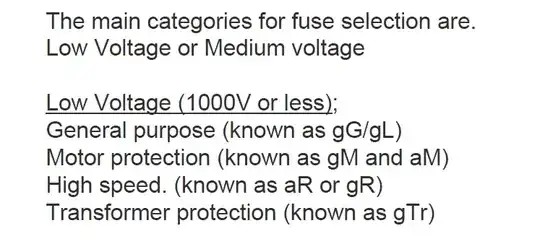I noticed that circuit breakers have a gl/gG rating. eg: gl/gG= 100A. Can someone explain the significance of this rating?
-
I believe that gG is used for fuses only, and not for circuit breakers. Circuit breakers have a different kind of characteristics, of which type "C" is the most common. Please correct me if I am wrong. – Mads Skjern Feb 20 '21 at 19:12
2 Answers
This should be covered by IEC 60269. gG and gL is the same thing where gL is an older definintion.
Quote From Wikipedia article about IEC 60269
The application cateogory is a two-digit code. The first letter is a if the fuse is for short-circuit protection only; an associated device must provide overload protection. The first letter is g if the fuse is intended to operate even with currents as low as those that cause it to blow in one hour. These are considered general-purpose fuses for protection of wires.
The second letter indicates the type of equipment or system to be protected:
D – North American time-delay fuses for motor circuits, UL 248 fuses
G – General purpose protection of wires and cables
M – Motors
N – Conductors sized to North American practice, UL 248 fuses
PV – Solar photovoltaic arrays as per 60269-6
R, S – Rectifiers or semiconductors as per 60269-5
Tr – Transformers[citation needed]
Any fuses built to the IEC 60269 standard and carrying the same application category (for example, gG or aM) will have similar electrical characteristics, time-current characteristics, and power dissipation as any other, even if the fuses are made in the packages standardized to the earlier national standards.
Unquote.
The gG/gL 100A that is mentioned in the question should be the fuse current rating. The current that a fuse in series with the device can continously pass through without opening.
According to the comment below, the device marked with gG/gL is a Motor Starter Protector (MSP). This should be put in series with a fuse that won't trip unless a short circuit fault occurs. Not even a stalled motor should trip it. Have a look at Rockwell Automations has a paper "193-2.10: A Guide to Understanding: Short-Circuit Protection" which deals with this. There is mentioned that the fuse should handle approx. 6 to 8 times the Full Load Current. This corresponds quite well to the MSP mentioned in the question.
Here is a picture of how the MSP and Fuse works together:

- 3,598
- 18
- 24
-
The only issue is that it doesn't make sense for this controller to be rated at 60A. This is the device I'm talking about. Its should open at 9-12.5A, so gG/gL of 60A doesn't make sense. – SivaDotRender Sep 08 '14 at 15:52
-
-
Another term often used in conjunction with gL/gG is "fast acting", see page 1, second column, first paragraph of https://rexel-cdn.com/Products/Littelfuse/DZ16F25.pdf?i=D03B0BA1-AE11-47D7-9F34-D54F6F1299A7 – Pro Backup Jan 24 '22 at 13:42
According to this: gL/gG class fuses are general purpose and rated for 1000V or less.

- 397,265
- 22
- 337
- 893
-
The only issue is that this gG/gL rating has a current associated to it. eg gG/gL = 60amps. What does this current mean?. Its not the CB's current rating because this is different (in my case 9.5-15 amps) – SivaDotRender Sep 05 '14 at 04:07
-
I believe that would be the maximum breaking capacity, so there should be a fuse in series no larger than that. – Spehro Pefhany Sep 05 '14 at 05:03
-
@SpehroPefhany "this" url https://www.profuseinternational.com/wordpress/wp-content/uploads/2012/10/ProFuse-Fuse-School-Module-2.pdf is no longer available. – Pro Backup Jan 24 '22 at 13:32